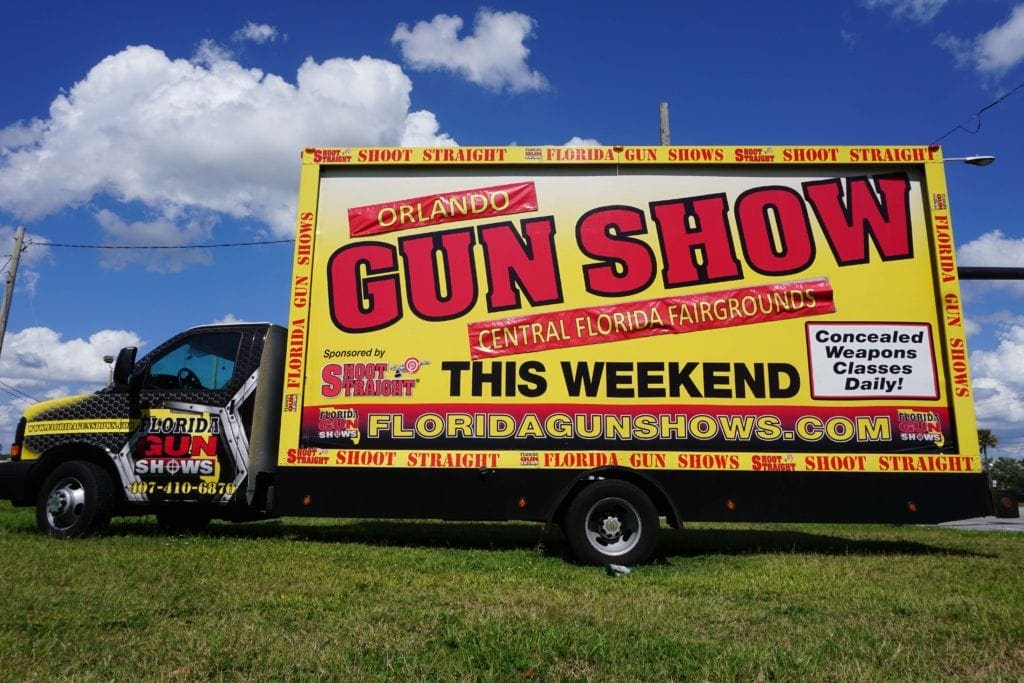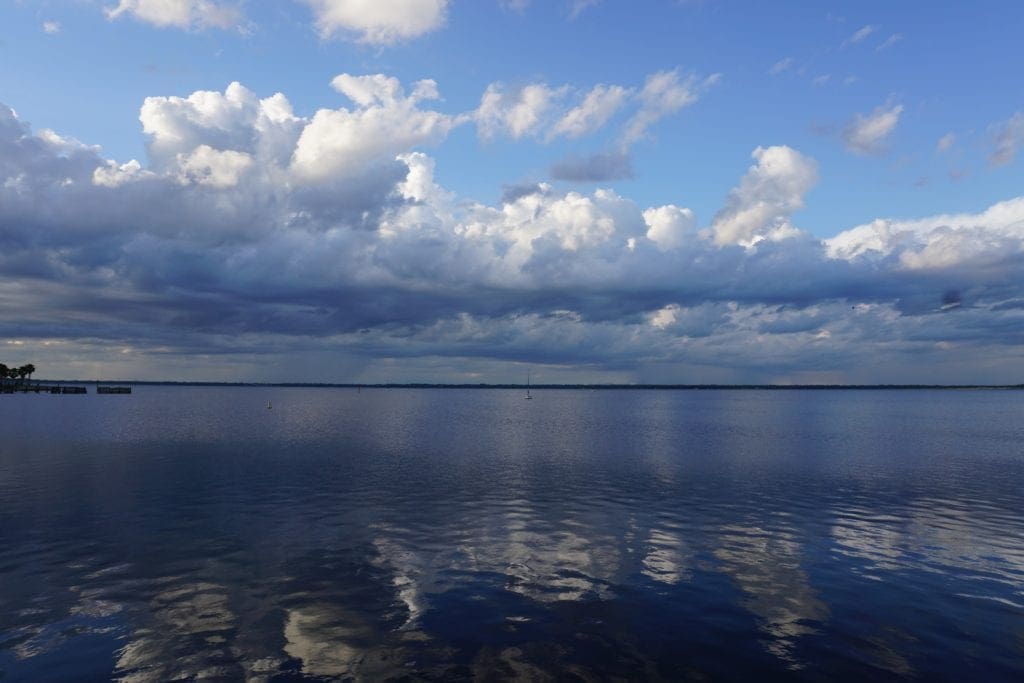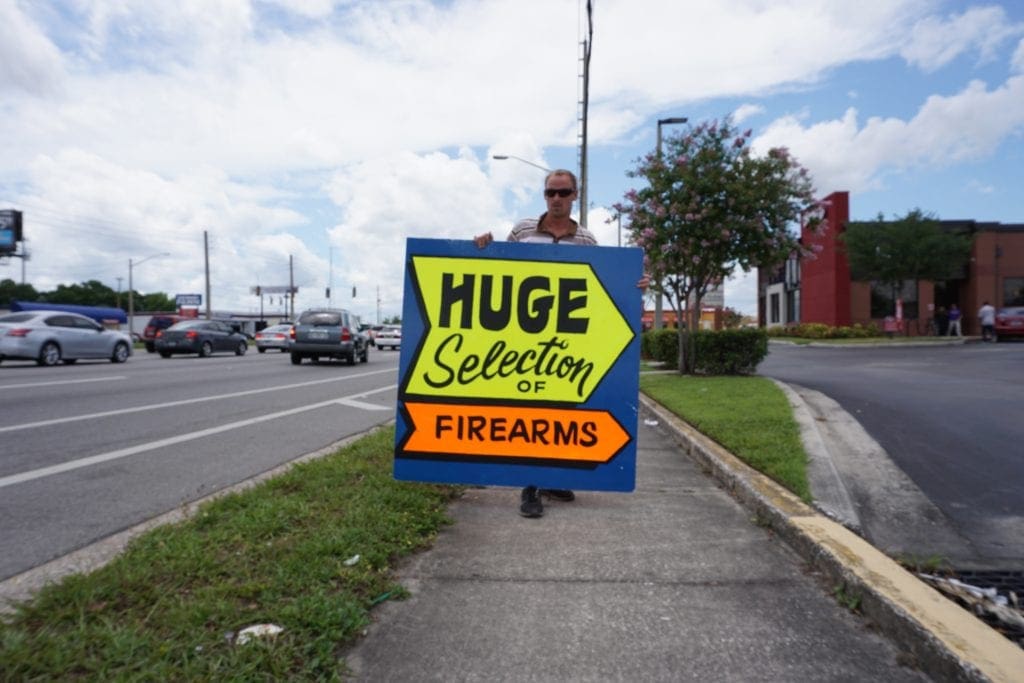Kung Li is currently on a three month investigatory tour focused mainly in the South to better understand how mass criminalization has impacted our belief system, how it has distorted our democracy and whether it is a cause of increasing fragmentation of our country. This post originally appeared on Solutions Not Punishment (SNaP).
This particular Smith & Wesson Shield is 20% off, yours for $379. The upgrade (with hand tuned action, fiber optic sights, ported barrel and slide, and other benefits I do not follow) is $529. A young white man, thin as a stork and extraordinarily polite, shows me a revolver with a barrel that holds eight bullets rather than the usual six. Here is one where the barrel is longer than usual, allowing it to fire a shot shell. Here is a particularly durable Glock favored by Special Forces units, who “run them like Gatlings.” I duck behind a display of Top Quality Beef & Ostrich Jerky to confer with my phone. Google tells me a Gatling was an early version of a machine gun.
I am at the Florida Gun Show in Orlando, where two of the Central Florida Fairgrounds’ aluminum warehouse are stuffed full of guns and lovers of guns. It is the day after Donald Trump accepted the endorsement of the National Rifle Association. In his acceptance speech, the Donald told the NRA loyalists something quite extraordinary. While President Obama has been releasing “violent criminal from the jails…by the thousands,” Trump told the crowd, the current President’s actions are nothing compared to what Hillary Clinton plans to do. She intends to “have them all released!” At which point she will “take away your guns!”
Should I tire of browsing through guns, I can, if I wish, take a 2 hour concealed weapons course, get a background check for $5, enter a raffle to win a rifle, shake hands with a candidate who will Restore America’s Prominence, become a member of the NRA, or eat pulled pork barbeque with just the right tinge of char. There are a variety of “Trump for President” t-shirts for sale. There is a “Hillary for Prison” t-shirt. There are rolls of toilet paper with Hillary’s face printed on it. A woman selling t-shirts that lets you know “Ladies If Your Boyfriend Doesn’t Know How to Fire a Gun You Have a Girlfriend” is next to a booth encouraging women to “Be a Babe!” by buying a very large gun.

The browsers are mostly white, but not all. A group of Latino men sporting bandanas bandy-leg down the aisles. A young Black man, tank top hanging off his skinny shoulders, counts twenties from a roll the size of his fist. His friends examine the gold revolver he has selected. A lone Asian guy goes around asking about specs and taking notes. That’s me. Gun prices range from the $119 Jimenez pistol – cute as a button, albeit more lethal – to $4,599 for an antique Springfield rifle. Besides guns, there are knives, paintball supplies, arrows, stunguns, holsters, conceal carry belts, slingshots, and fried peanuts.
I hate guns.
Oh, this one feels nice.
I hate guns.
Oooooh, pretty! I want this one.
I buy a bag of fried peanuts instead and go back to the table worked by the gangly white kid. His name is Chris and he is a third year mechanical engineering student. We talk about engineering: rearward translation, slides and recoil. Does he plan to take his engineering degree into gun design?
“Oh no sir,” he says. “I don’t want to develop killing machines.” Solar panels are what he’s thinking. I can’t quite believe I heard correctly and ask him repeat what he just said. I heard correctly. How, I ask him, did a nice kid like him end up in a place like this?
He was in bed one night when someone came through his window to rob his house.
“I was afraid,” he says simply.
***
NRA-landia
NRA-landia is full of fear. Their new guy Trump (who wasn’t always their guy) has embraced their view that the government is simultaneously turning loose “violent criminals” and taking away the guns they, the law abiders, need to protect themselves.
When Trump says “violent criminals,” the people at this gun show hear “Trayvon Martin.”
It is a 20 minute drive north to Sanford.
The town is not at all the weedy broken concrete I expected. Sanford sits graciously on the south shore of Lake Monroe. I ask Greg, a thritysomething white man, about George Zimmerman, who has just auctioned off the gun he used to kill Trayvon Martin for an unconfirmed $250,000.

“That man is not right,” Greg says, and turns back to his giant pretzel. We are at a German restaurant where a man in lederhosen plays the accordion for a foursome of eightysomethings dancing in a tight circle. Up the street on a broad green lawn, a group of thirty four teenage girls are killing a Beyoncé/Flawless dance routine.
The lawn where the girls are drilling is on the grounds of what had been Fort Mellon, built during the Second Seminole War. The historical marker reads:
Site of Fort Mellon formerly Camp Fanning where on February 8, 1837 during one of the fiercest battles of the Seminole Wars Captain Mellon was killed in an attack of 400 braves and by King Philip and Coacoochee.
The reader of this marker imagines Captain Mellon poking at a campfire, sipping tea, when suddenly he is descended upon by 400 braves and cut to pieces. This is standard issue Daughters of the American Revolution history – just enough words to make the aggressors appear the victims and not a sentence more.
A more accurate historical marker might read:
The first two Seminole Wars were pressed by Andrew Jackson, who made his name in the Tennessee Militia and then the US Army, fighting three different wars in the south with a single goal in mind: kill or deport Native Americans to make way for slave plantations. As President, Jackson pushed through the Indian Removal Act in 1830, resulting in the forced expulsion of the Cherokee, Muscogee, Chickasaw, Seminole, and Choctaw via the Trail of Tears. The Seminoles refused. Black runaways who lived among the Seminoles were especially adamant about standing their ground. This was the crux of the problem for President Jackson – so long as the Seminoles remained in Florida, enslaved people had a place to run. In 1835 he sent troops into Florida to force out the Seminoles. Camp Fanning at this site garrisoned over a thousand U.S. soldiers sent to hunt down and destroy Seminole villages. A village located 12 miles east of here gathered a force of Seminole and Black Seminole fighters led by Chief King Philips’ son Coacoochee forced the U.S. Army to abandon this Fort.
The 1837 battle at what is now Sanford happened in the last days of Andrew Jackson’s presidency. It was a disastrous presidency that expanded and strengthened the institution of slavery by forcing Native Americans off the land the white planters wanted for cotton plantations. We might want to remember what happened the last time a larger than life populist candidate upended the party establishment and won the presidency by stoking the twin fires of white fear and white supremacy.
***
Fifteen miles west of the Florida Gun Show is another town with a cautionary tale of the white berserks that can break out when nonwhite people insist on standing their ground.
On Election Day in 1920, Mose Norman, one of the state’s few Black orange grove owners, and July Perry, a deacon of the Ocoee AME Church, went to vote. Two large KKK marches the night before had warned them – and every other Black person in town – to stay away from the polls. When Norman was physically barred from voting, he drove to Orlando and sought the advice of a judge. The judge assured Norman it was illegal for him to be barred from voting. Norman returned to the voting place, this time with a loaded shotgun. A group of poll workers and their “protectors” pinned Norman down, beat him with the butt of his gun, and forced him away.
A 100+ person mob of whites gathered and went to July Perry’s house, looking for Norman. When they tried to break down the front door, Perry fired and kept firing from inside the house, killing two whites as they tried to enter the back door.
The mob retreated, then called in reinforcements.
Within hours, fifty cars full of Klansmen from Sanford, Orlando, and Winter Garden poured into Ocoee. Perry was arrested and almost immediately lynched, hung from a telephone pole and shot to ribbons. Unsatisfied, the white mob stormed the two black neighborhoods of Ocoee and set fire to the houses, shooting people as they ran out. By 4:45 am, the 500+ Black residents of Ocoee were all dead, too injured to escape, or driven out into the swamps surrounding town.
For the next week, the KKK blockaded the town, ensuring no Black resident could return. For four decades, Ocoee was an all-white town. The total number of deaths remains unknown, but at least 34 and more likely closer to 56 Black people were killed by the white mob, making it the “bloodiest day in modern U.S. political history.” Its death toll exceeded the more famous Rosewood massacre, which would happen two years later a hundred miles to the north. Unlike Rosewood, though, victims of the Ocoee massacre remain unrecognized, uncompensated and largely forgotten.
***
Ocoee today remains agricultural, with chickens for sale and train tracks burrowing through a canopy of old growth pines. It is a different place in many respects – its 40,000 residents now include a sizable Latino population and about a thousand Black families – but the sulky taint of shame still hangs in the air of the place.
I am driving out of Ocoee when NPR’s story comes on about Trump’s acceptance of the NRA’s endorsement. The commentator notes that Trump read from prepared notes when he declared “Hillary wants to disarm vulnerable Americans in high-crime neighborhoods.” This was not an off-the-cuff speech. Quite the opposite. With Florida promising to again be a critical battleground state, Trump’s NRA comments about “violent criminals” seem carefully, finely tuned to the psyches of my fellow gun fondlers at the Florida Gun Show.
His message: Be afraid! I will protect you!
But what, exactly, is he exhorting them to be afraid of?
There is already plenty of fear among the aisles of the Florida Gun Show. There is my lanky guide Chris’ fear of burglars, certainly. The term “home invasion” at the gun show is as prevalent as do-si-dos at a square dance. But there is more to it.
There is the fear of being a sissy. There is the fear of background checks and waiting periods. There is even, quite fantastically, the fear of trans* people. (After Target recently said its customers are of course welcome to use the bathroom that matches their gender identity, it was an Orlando attorney and Liberty Council President who declared that she would be bringing her gun into the bathrooms of Target “for protection” against “pervy men using the women’s room.”)
But these are trivial fears. (Though not entirely trivial. At Target to buy a pair of socks, I need to pee. Which bathroom? If I go into the women’s room, as per the Liberty Council President’s preference that I use the bathroom matching the gender marker on my birth certificate, what if the Liberty Council President is in fact staking out the bathroom? Will she decide I’m a “pervy man using the women’s room” and shoot me with her very large gun? I decide I don’t need to pee.)
Anyway, these are trivial fears. There is something deeper, something more.
If the gun auction site’s claims turn out to be true, someone just paid a quarter of a million dollars for George Zimmerman’s gun, which he hawked as “a piece of American history.” A used Kel-Tec PF9 9mm goes for about $250. Whatever American history was worth $249,750 to somebody certainly stretches back much further than the single case of homicide that left Trayvon Martin dead.
Some of what the buyer of Zimmerman’s gun bought for a quarter million dollars was the American history of things taken by force through superior firepower. Here within a 20 mile radius of the Florida Gun Show, those things include: Seminole land, Black freedom, the town of Ocoee, and Trayvon Martin’s life. It is an almost incomprehensible litany of losses. It is a list of wrongs that have not been made right.
George Zimmerman, meanwhile, is giving interviews accusing Sabrina Fulton and Tracy Martin of causing their son’s death because they “didn’t raise their son right.” When asked about the decency of putting the gun up for auction, he puffs on a cigar and brags about his intention to end the Black Lives Matter movement.
It all calls to mind something Thomas Jefferson confessed in a moment of startling candidness. In Notes on the State of Virginia (1785), the slave owning drafter of the Declaration of Independence articulated what must have been the most profound fear of all the founding fathers who espoused freedom while participating in slavery.
“I tremble for my country,” Jefferson wrote, “when I reflect that God is just and that his justice cannot sleep forever.”
Maybe this is the deep fear the NRA is tapping into. What the NRA demands is unfettered access to as many guns as a “law-abiding citizen” can buy. Here in central Florida, teeming with wrongs that have not been made right, is it the promise of divine justice that is causing the certain unease I feel among the browsers at the Florida Gun Show? Is some version of Jefferson’s fear and trembling behind the urge to stockpile guns upon guns upon guns?
All the wrongs that have not been made right. A Remington R-25. A long range rifle scope. A Berretta Cougar. A Springfield 1911 with its pinpoint accuracy. Two matching Ruger GP-100s, one for him, one for her. All the injustices awaiting divine retribution. Better get a speed loader and a conceal carry purse. Better buy an ammo bunker and fill it with every type of cartridge: .38 Specials .44 Magnums. .45 ACPs. At the end of this gun show, the vendors pack up and talk about the next one, in Miami. Someone mentions Hillary Clinton will be speaking near there, at the Trayvon Martin Foundation gala in Fort Lauderdale. Their partner packs up the shooting targets and shrugs. Nothing better for sales than the threat of gun control. The more they fear, the more they buy. The more they buy, the more they fear. There is no end to it. Someday divine justice may yet awaken. Someday, but not yet. Until then, it will continue to be a good day at the Florida Gun Show.
